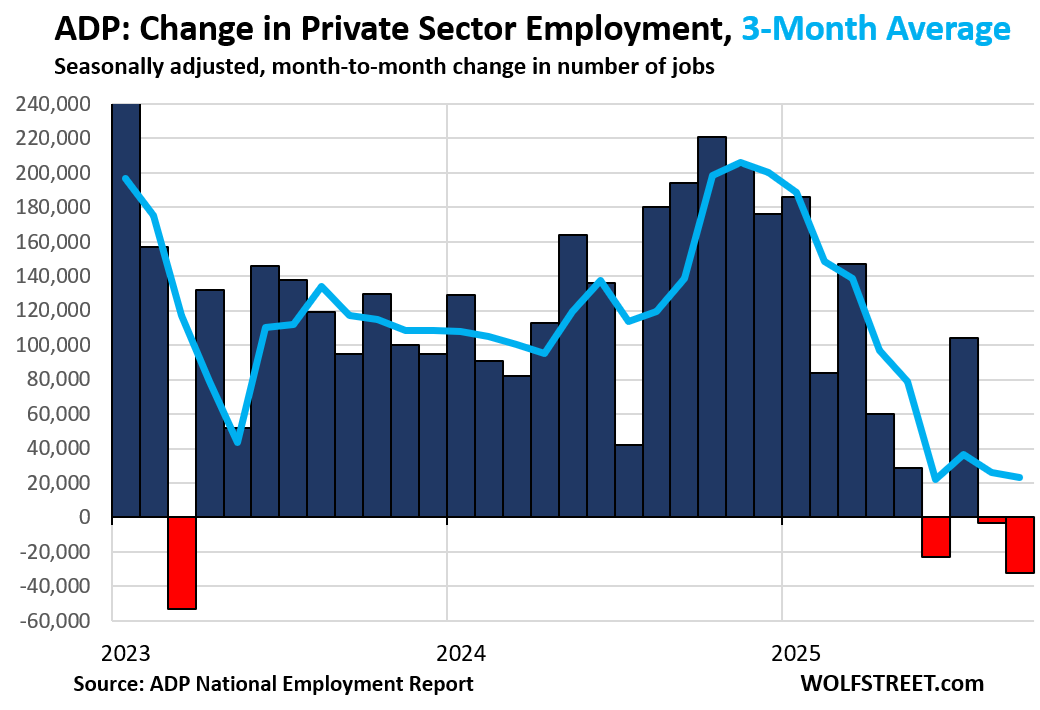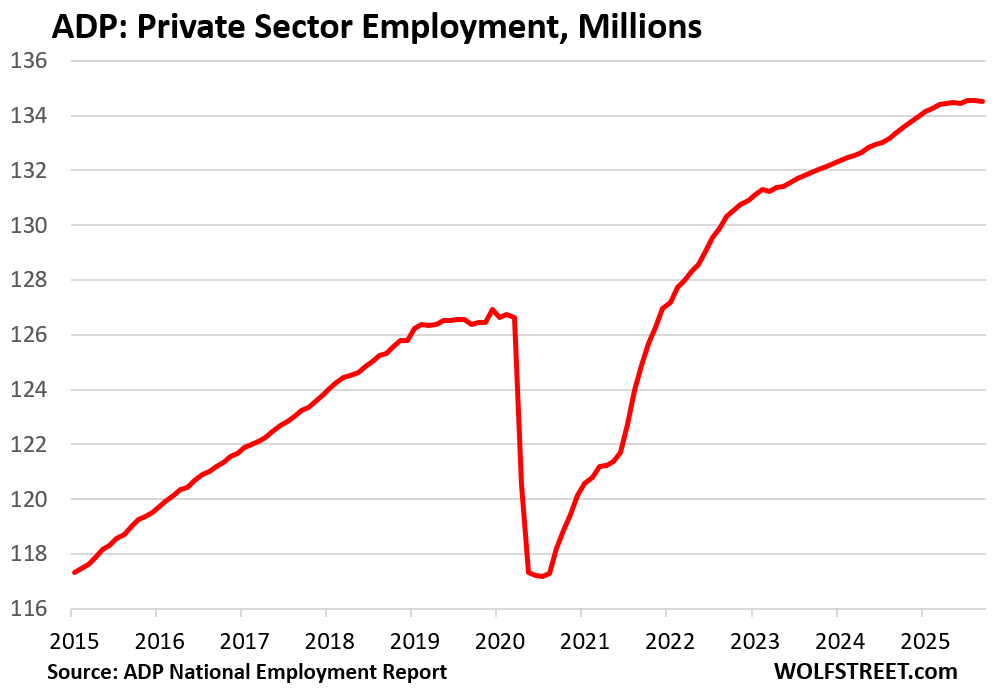Pre-benchmarking jobs: +11,000. Private-sector measures not immune to data mess. Trend shows “employers have been cautious with hiring.”
By Wolf Richter for WOLF STREET.
Payroll processing firm ADP conducted its annual preliminary adjustment today to the full-year 2024 Quarterly Census of Employment and Wages data released by the Bureau of Labor Statistics on September 9. The QCEW provides a quarterly count of Paid Employment based on the quarterly payroll tax filings by employers, covering about 95% of payroll jobs, but the BLS releases it annually with a long lag. On September 9, the BLS announced its own preliminary benchmarking adjustment to the QCEW for the 12-month period through March 2025 (we discussed this mess here). Today it was ADP’s turn.
As part of the annual adjustment, ADP reduced its September job count by 43,000 jobs. Companies added 11,000 jobs to their payrolls in September, per pre-benchmarked data. The 43,000-job adjustment to benchmark the data to the 2024 QCEW took this small job gain to a job loss of 32,000.
Same thing for August: ADP applied the 2024 QCEW benchmark adjustment of 57,000 jobs to the August job gain of 54,000 jobs, which flipped it to a job loss of 3,000. The ADP data is seasonally adjusted.

The erratic month-to-month changes and adjustments are somewhat leveled out with the three-month average (blue line in the chart above), which shows a substantially slowing job growth, which is what we have seen in other data as well.
“Despite the strong economic growth we saw in the second quarter, this month’s release further validates what we’ve been seeing in the labor market, that U.S. employers have been cautious with hiring,” ADP said.
Total employment in the private sector, per ADP, was 134.53 million, up by 1.15 million from a year ago, after the benchmark adjustments:

The median increase in wages in September, year-over-year, based on a subset of 14.8 million workers employed for at least 12 months, whose paychecks ADP processed:
- For “Job Stayers”: +4.5%, roughly the same increase as over the prior 6 months.
- For “Job Changers”: +6.6%, down from the 7.0% to 7.1% range in the prior 6 months.
Due to the government shutdown, the BLS may not release its employment report on Friday, and the ADP data may be all we get for now in terms of payroll count and wages for September.
Enjoy reading WOLF STREET and want to support it? You can donate. I appreciate it immensely. Click on the mug to find out how:
![]()


A passing thought: Much of this “strong economic growth” revolves around the rapid growth of A.I., where the goal of A.I. is to eliminate the need for human labor.
IOW, this isn’t just another economic cycle, it’s a sign of the future.
Bingo. I am not sure why there has not been a correlation with job losses vs AI. Like the internet age of the 90s, this isn’t new. The only difference is the product being made. The internet was a change for all income levels, even at its infincy. AI will most likely not benefit the average Joe/Jane. Business is ahead on this one.
One of these days, I would love to see a list of jobs that AI will replace (the human).
Coming out of heavy manufacturing, and then the oilfield (engineering and construction), I can’t see the mass of eliminations.
Look up the post from ADP “Yes, AI is affecting employment. Here’s the data.”
Includes a link to a research paper that estimates which jobs are exposed to AI.
That paper’s title is “Canaries in the Coal Mine? Six Facts about the Recent Employment Effects of Artificial Intelligence”
I use Google AI all the time. So much so I practically stopped clicking on most links in the Google search. Is Google planning to monetize my “not clicking/not visting websites” somehow?
Also, when I need to know the truth about the economy I skip AI industrial complex and go directly to Wolfstreet ;-)
This downward revision caused the major market indices to begin climbing this morning, I would believe, despite the government shutdown beginning.
It seems like the market is drunk on the idea of rate cuts. Bad employment data used to mean recession coming, market down. Now bad employment data means better chance of rate cut, market up. When the correction finally happens it could be epic.
Except the data isn’t that bad. Employment is essentially full. The UE rate for 25-54 year olds is 3.6%. It was 3% in 2022, so it has barely inched up.
I meant to add that the labor participation rate for the same group is 83.7. It was 83.9 last year but around 82 in 2022. Then it flattened for about a year, then accelerated.
Yep. It’s more that the market is thinking “The data is just bad enough to give the Fed cover to what it wants to do anyway, which is drop rates to 0 (ultimately), but not so bad that there’ll even be close to a recession.”
Not saying I agree, but that’s the narrative.
I agree. I’m still of the opinion that the FED should have ignored the employment mandate and shut off inflation almost immediately. Inflation is just a killer for everyone, job or no job.
Wolf, how does deportation affect ADP data? My question is if people with jobs getting paid with adp payroll under some migrant #ITIN number get deported they fall off the monthly payroll. Correct? So if 5k per month with migrant #itin get deported who had paying jobs in the surveyed data would be 5k fewer workers worked, correct? Or wrong? Please provide clarification if you know the answer. I know migrants work under migrant #itins without proper green cards and or h1 visa, I understand it’s easy to get a migrant #itin number without work authorization, technically they could be be counted and are paying our taxes for us without representation or benefits to themselves except income for time traded. Is ADP data flawed due to deportations?